

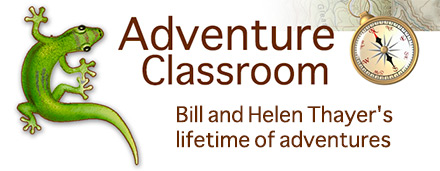
JOSHUA TREE NATIONAL PARK
Unless otherwise noted, photos (c) Helen Thayer
Joshua Tree National Park is unique because it encompasses parts of two deserts. The lower southern area is called the Colorado and reaches an altitude of 3,000 feet. The Mojave Desert in the northern region ascends to an altitude of almost 6,000 feet. The entire Park covers an area of 800,000 acres of which 75 percent of the Park is designated as wilderness. Currently the Park contains over 700 plant species, 240 bird species, 40 mammals, and 45 reptile species.
Helen Describes Her Visit to Joshua Tree [Page One]
Humans have occupied the Park for at least 5,000 years. The first group known to inhabit the area was the Pinto Culture, followed by the Serrano, the Chemehuevi, and the Cahuilla. They hunted and gathered food along a slow-moving river that ran through the now dry Pinto Basin. Later, other American Indian groups traveled through this area to harvest pinyon nuts, mesquite beans, acorns, and cactus fruit, leaving behind rock painting and pottery as evidence of their passing. However the indigenous people had left the area by 1913
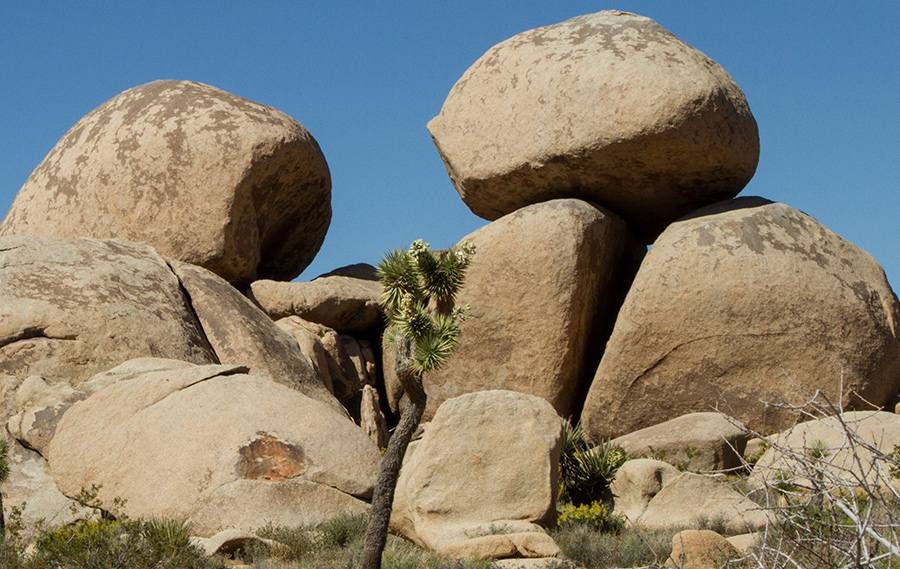
Stacked block boulders
Acording to legend, a party of Mormon emigrants passed through the area in 1851. They took courage from the trees upraised limbs that seemed to beckon them into the desert. They are reported to have said, "Just as in biblical times, Joshua called forth the Israelites. These green trees are lifting their arms to heaven in supplication. We shall call them Joshua trees!"
Homesteaders arrived in the 1930's seeking free land and the chance to start new lives. They built cabins, dug wells, and planted crops. As Southern California grew so did desert visitation. Expanded automobile traffic found its way to the area. Weekend Californians came to the desert to enjoy the clean air, but also to confiscate various species of cactus for their home landscaping. When Mrs. Minerva Hamilton Hoyt, a wealthy California society matron saw the devastation left by these weekend visitors, she persuaded President Franklin D. Roosevelt to protect this area by proclaiming it a national monument on August 10th, 1936. After the area became a national monument, local and regional residents were still the primary visitors.

Tilted sedimentary rock
When President Clinton signed the California Desert Protection Act in 1994 the legislation allowed Joshua Tree National Monument to gain National Park Status. As a next-door neighbor to the highly populated Los Angeles area, Joshua Tree is now a very popular getaway, but the park still remains a low-key place of unique geography and wilderness.
GEOLOGY
The story of Joshua Tree's geology begins nearly two billion years ago, when Earth was about half its present age. As eroded sediments washed off ancient continents into the ocean, thick sediment layers accumulated in the waters offshore. Over time, the bottom layers were compressed and fused into sedimentary rock. The geologic landscape of Joshua Tree has long fascinated visitors to this desert. How did the rocks take on such fantastic shapes? What forces sculpted them? Geologists believe the face of the modern Park landscape was born more than 100 million years ago. Molten liquid, heated by the continuous movement of Earth’s crust, oozed upward and cooled while still below the surface. These plutonic intrusions are a granitic rock layer called monzogranite.

Beaver-tailed cactus
The monzogranite developed a system of rectangular joints. One set, oriented roughly horizontally, resulted from the removal—by erosion—of the miles of overlying rock, called gneiss (pronounced “nice”). Another set of joints is oriented vertically, roughly paralleling the contact of the monzogranite with its surrounding rocks. The third set is also vertical but cuts the second set at high angles. The resulting system of joints tended to develop rectangular blocks. Good examples of the joint system may be seen at Jumbo Rocks, Wonderland of Rocks, and Split Rock.
As ground water percolated down through the monzogranite’s joint fractures, it began to transform some hard mineral grains along its path into soft clay, while it loosened and freed grains resistant to solution. Rectangular stones slowly weathered to spheres of hard rock surrounded by soft clay containing loose mineral grains. Imagine holding an ice cube under the faucet. The cube rounds away at the corners first, because that is the part most exposed to the force of the water. A similar thing happened here but over millions of years, on a grand scale, and during a much wetter climate.
With the arrival of the more arid climate of recent times, flash floods began washing away the protective ground surface. As they were exposed, the huge boulders settled one on top of another, creating those impressive rock piles we see today.
Visitors wonder about the “broken terrace walls” laced throughout the boulders. These are naturally occurring formations called dikes. Younger than the surrounding monzogranite, dikes were formed when molten rock was pushed into existing joint fractures. Light-colored aplite, pegmatite, and andesite dikes formed as a mixture of quartz and potassium minerals cooled in these tight spaces. Suggesting the work of a stonemason, they broke into uniform blocks when they were exposed to the surface.
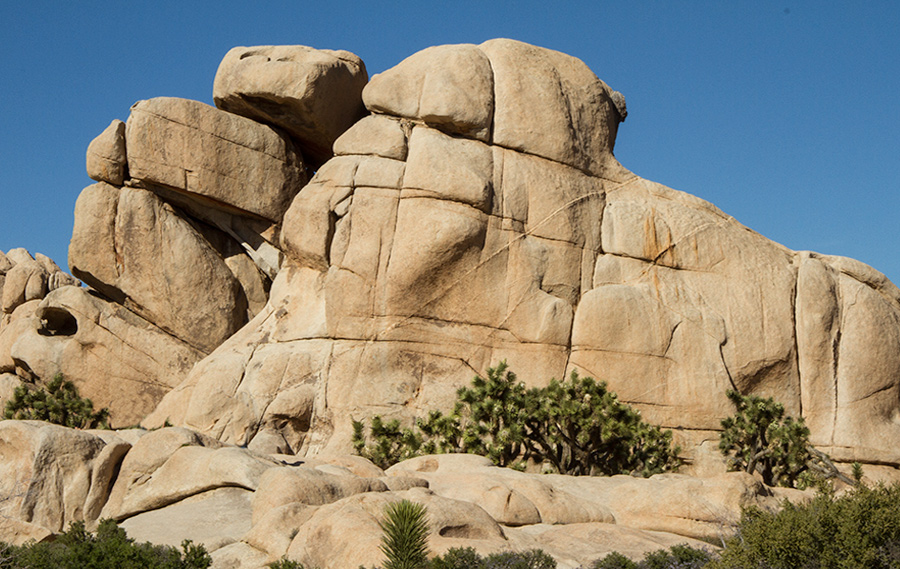
Broken terrace wall
DESERT LIFE
A diverse population of animals makes their homes in Joshua Tree. Birds, lizards and ground squirrels are most likely to be seen during the day. However, at night desert animals come out to roam in the cooler temperatures. The nocturnal animals include snakes, bighorn sheep, kangaroo rats, coyotes, lynx, and black tailed jackrabbits. Animals that thrive in the Park have adapted to the limited water and high summer temperatures. The smaller mammals and all reptiles take refuge from the heat underground. Reptiles are physiologically adapted to survive with little water, and birds can fly to water sources when they need to drink. Nevertheless, the springs and seeps in the park are necessary to the survival of many animals. Most of the reptiles and many small rodents and insects go into an inactive state of hibernation during the winter. However, winter is the time of greatest bird concentrations in the park, because of the presence of many migrant species that winter-over in the Park due to warmer winter temperatures.

Joshua Tree flower
Occasionally visitors see the roadrunner, the bird of cartoon fame. The roadrunner is a member of the cuckoo family and prefers to spend most of its time on the ground. With its long legs it can run at speeds up to 20 miles per hour. Roadrunner feathers were traditionally used to decorate Pueblo Indian cradleboards as spiritual protection for the baby. In Indian tribes, such as the Pima, it is considered good luck to see a roadrunner. During the cold desert night, the roadrunner lowers its body temperature slightly, going into a shallow hibernation to conserve energy. To warm itself during the day, the roadrunner exposes dark patches of skin on its back to the sun. The roadrunner usually lives alone or in pairs. Breeding pairs are monogamous and mate for life, and pairs often hold a territory all year.
Heading the list of native plants is the Joshua tree. Although called many unflattering names it is commonly found in the higher elevation of the Mojave Desert that comprises the northern area of Joshua Tree National Park and has become the signature plant of the Park. No two trees are alike. The branches that look more like arms as they reach out in all directions seemly with no pattern or direction, give the tree a rugged look. Members of the Agave family, and although referred to as trees, their trunks have no growth rings, making it a challenge to determine their exact age. Some trees reaching heights of 30 or more feet are thought to be several hundred years old. Adult trees grow less than one or two inches a year. Instead of growth rings the trunks are filled with a solid fleshy pulp. As the dark green pointed leaves die, they fold down to cover the outside trunk in a stiff woody shag. Clusters of creamy white flowers appear on the tips of the branches in spring. The process of flowering causes the branch to split in two, creating another branch that accounts for the endless diversity of Joshua tree shapes.

Yucca in bloom
Flowering depends on a winter freeze followed by spring rain. Experts believe that the winter freeze damages the ends of the branches that in turn stimulates flowering. After the flowers die they form large clusters of hard shelled seedpods. Many species of cacti are found in the Park, such as the bright red flowers of the claret cup, hedgehog and beaver tail cactus varieties. The numerous varieties of flowers include the bright yellow desert dandelion that is widespread especially after adequate spring rains. The white trumpet-like sacred datura likes the edges of the sandy backcountry roads. Although extremely toxic and hallucinogenic, it was used in Indian religious ceremonies, such as rites of passage into adulthood.
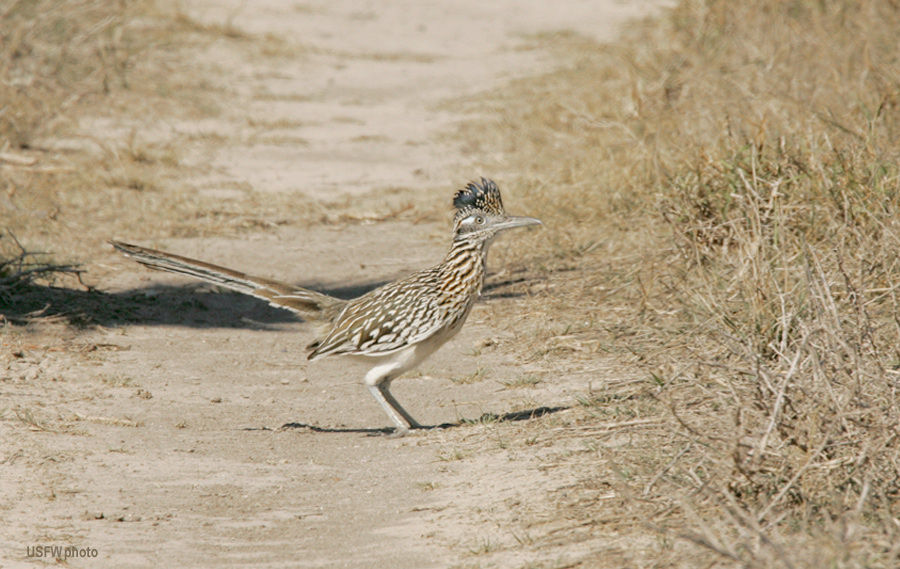
Roadrunner
The creosote bush is the most widespread desert plant in American deserts. Growing to a height of 10 feet tall it has olive green leaves and following adequate spring rain it produces an abundance of small yellow flowers. With no natural predators the creosote bush has spread throughout the American deserts. Its roots release toxins and choke off water supply to kill off any surrounding plants, thereby choking out any competition. The creosote can survive temperatures well over 100 degrees and extended periods of drought. Their leaves are covered in a waxy resin that prevents moisture loss and they repel animals with their repugnant taste.

Desert in super bloom
RECREATION
For the desert hiker, Joshua Tree National Park is a paradise. For those seeking far off views there are ten peaks higher than 5,000 feet. For easy hiking there are nine easy well maintained trails. However even the most experienced hiker should respect the special dangers that desert hiking can provide. Dehydration is the most obvious concern. The desert's hot daytime temperature and exceedingly dry climate quickly robs the body of moisture. A standard rule of thumb is that each hiker take a gallon of water per day when hiking long distances. And don't forget sunglasses and sunscreen.
Do not enter abandoned mines. Some of the approximately 300 abandoned mines in the Park still contain open shafts and deep tunnels that drop into a dark abyss hundreds of feet deep.

Desert Rattlesnake
On rare occasions visitors have found rattlesnakes and scorpions in the Park. The most dangerous snake is the venomous rattlesnake also known as the "Mojave green". It is a pit viper species and is best known for its potent neurotoxic-hemotoxic venom, which is considered the world's most potent rattlesnake venom. However rattlesnakes are not an aggressive species. It is always best to leave them undisturbed and give them plenty of space. Normally they are happy to avoid human contact. Never reach under rocks or into any places you can't see and always watch where you step. Unless you could experience an allergic reaction to a scorpion's venom scorpions are not dangerous.
If rain is in the forecast be aware of the possibility of flash floods. Avoid canyons and washes when rain clouds threaten.
An excellent reference guide book to Joshua Tree National Park is: JOSHUA TREE, the Complete Guide - Authored by James Kaiser
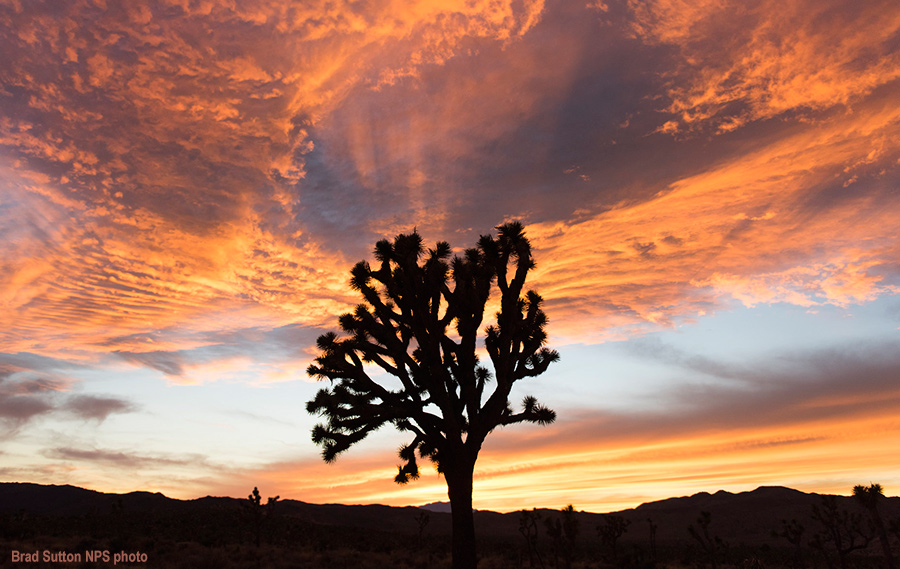
Magical sunset
Helen Describes Her Visit to Joshua Tree [Page One]
Back to [National Parks Index]
